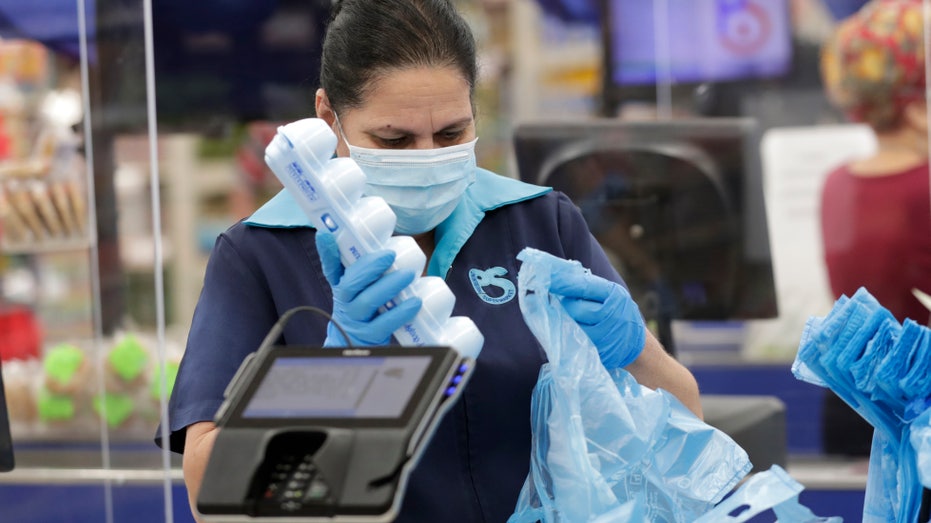Boost to household income primes US economy for stronger growth
Personal income rose 10% in January and spending grew 2.4%
U.S. households are getting a boost from pandemic-aid programs, priming the economy for a surge in growth this year.
The Commerce Department is set to report Friday on how much Americans earned and spent in January -- key indicators of the economy's health. Economists predict that consumer spending grew solidly last month while income soared, the latter by as much as 9.5%. Excluding last April when the first round of government aid reached households, such an increase in income would be the biggest on record dating back to 1959.
CLICK HERE TO READ MORE ON FOX BUSINESS
Under a $900 billion stimulus program signed by former President Donald Trump in late December, the federal government has been sending one-time cash payments of $600 to most households. It also has been paying jobless workers $300 a week on top of their normal unemployment benefits. Meanwhile, job growth resumed in January after a drop in December. And higher-income households, unable to travel or dine out, have built up a high level of savings.
"That combo will be quite powerful in driving consumer spending this year," says Lydia Boussour, senior economist at Oxford Economics. She and her colleagues project that by this summer, U.S. output will have fully recovered from last year's pandemic-related downturn, mainly because of a surge in consumer spending.
Oxford Economics predicts output will grow 7% this year, which would be the strongest growth in decades. In a Wall Street Journal poll earlier this month, economists on average expected gross domestic product to expand nearly 4.9% this year.
Gross domestic product fell 3.5% in 2020 compared with 2019, the Commerce Department said Thursday.

Cashier Vivian Castellano wears a protective mask as she works behind a plastic shield at the Presidente Supermarket during the new coronavirus pandemic, on April 21, 2020, in Hialeah, Fla. (AP Photo/Lynne Sladky)
Consumer spending is the biggest factor behind growth in the U.S. Spending soared in the summer, grew modestly in early fall and then fell the final two months of last year. The decline at the end of last year occurred as states and cities ordered businesses to shut or scale back again, as virus infections resurged, restricting consumers' ability to spend. Also, the effects of an earlier stimulus bill passed at the outset of the coronavirus pandemic faded.
Thanks to the new stimulus efforts and high savings among upper-income and wealthy households, households have money to spend. Income was above pre-pandemic levels in December, and the savings rate is historically high. New virus infections have been declining, and several big states, including California and Texas, eased restrictions in recent weeks.
Those developments appear to have already translated into a boost in consumer spending. Retail sales -- measuring how much households spent at stores and restaurants -- rose in January by the most since early last summer, earlier government data show. Friday's report will encompass how much they spent on all types of goods and services.
US DEFICIT SOARED IN JANUARY AMID NEW COVID-19 RELIEF SPENDING, CBO SAYS
Scott Molloy, 45 years old, was laid off in August as a senior project manager for a real-estate developer in San Diego. He started his own consulting business, restoring some but not all of his income.
Like most Americans, he has cut back on spending during the pandemic, mostly by not going out to eat or traveling, saving $300 to $400 a month.
But last week, not long after California's governor lifted dining restrictions, Mr. Molloy went out for burgers and beer with a friend at a pub near the ocean. And he has planned a trip for April to drive up to a second home in Oregon, visit relatives in San Francisco and visit friends in Lake Tahoe. He plans to fly back. "It will be a full-fledged vacation that I haven't taken in over a year," Mr. Molloy said.
Such spending will help the economy return to its pre-pandemic vigor, along with additional recovery in a labor market still digging out of the hole created by the pandemic. Consumer spending has held up well during the pandemic, as consumers shelled out more for goods, particularly long-lasting products such as cars, home appliances and items purchased online. Many people have also upgraded their homes.
GET FOX BUSINESS ON THE GO BY CLICKING HERE
The services side -- restaurants, nail salons, gyms, airlines -- however, continues to suffer. Services spending is expected to pick up this spring, as more people get vaccinated.
"People are going to travel more," Ms. Boussour says. "They're going to go back to restaurants and bars, they'll go back to the gym -- all the things they basically were not able to do before the pandemic. This is where you will really see a burst in spending."




















